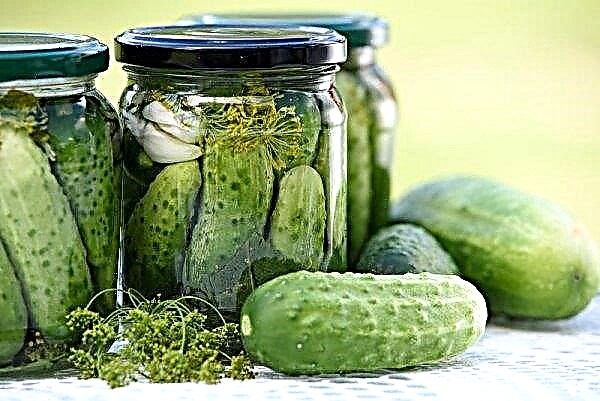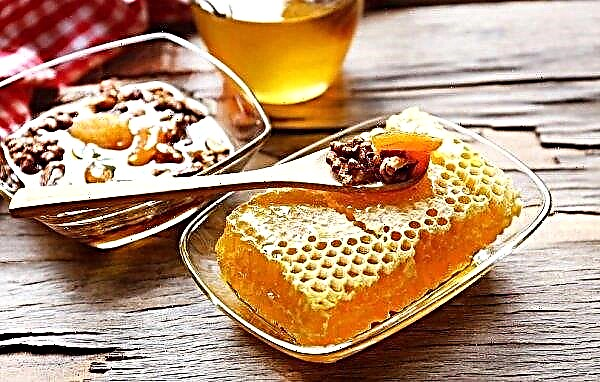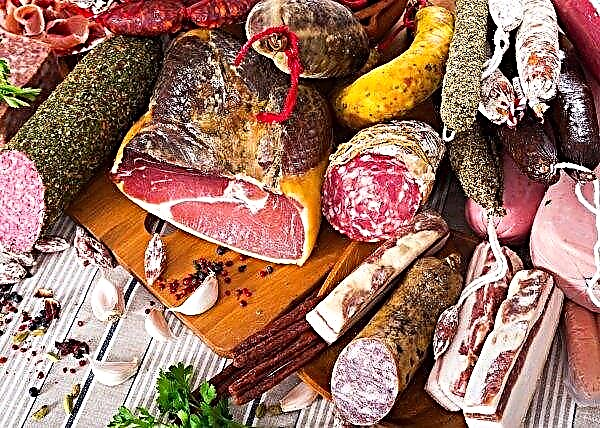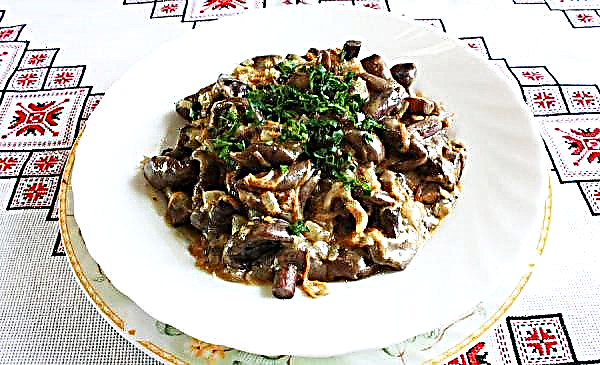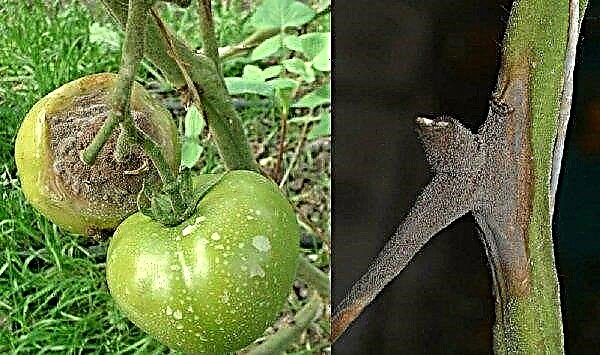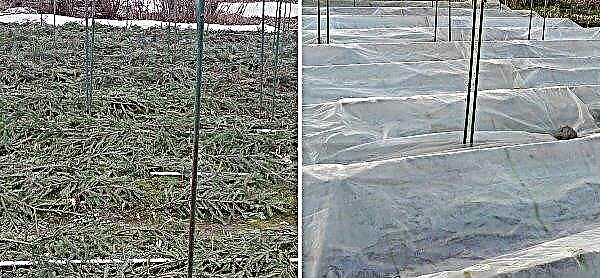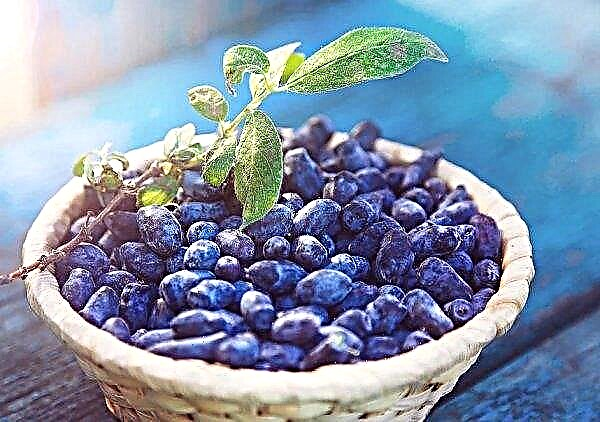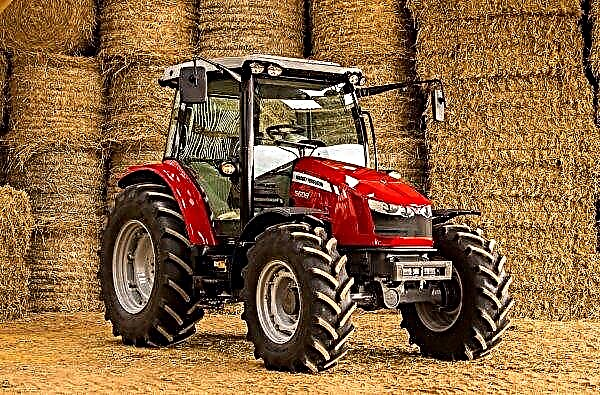Pepper is a well-known culture grown in different regions of our country and loved by everyone for its exquisite taste and availability of useful substances. It will be interesting to learn about its biological structure, structure, properties, cultivation conditions and areas of use.
Origin of vegetable
Pepper is one of the types of herbaceous plants of the annual type of the genus Capsikum of the Solanaceae family. It is grown in two forms: sweet (vegetable) and spicy (spicy). Its ancestral home are the tropical regions of America, in particular Mexico, Guatemala, Chile, where it grows as a perennial wild shrub. As a vegetable crop in this region began to be grown with the advent of the first agriculture in the XII-XI millennium BC. It came to Europe in the 15th century, and in Russia it began to be cultivated in the middle of the 19th century, gaining high fame and recognition. Now this plant is grown on all continents of the Earth, except Antarctica.
The most common varietal type is Bulgarian, which has large, thick-walled, fleshy short fruits. When ripening, they acquire a red, yellow, white, orange color. Recently, breeders have bred varieties of brown and black. Presumably, it owes its name “Bulgarian” to breeders from Bulgaria, who bred many large-fruited varieties that have become popular in many countries.
In biology, there are 4 varieties of culture: Mexican, Peruvian, Colombian and pubescent. The first variety - Mexican, includes almost all varieties of cultivated peppers.
Did you know? The leader in the industrial cultivation of bell pepper is China, in second place is Mexico, and in third place is the United States.
Pepper structure
These nightshade have a peculiar structure, due to their biological structure.
Root system
Pepper has a branched core root, which enters the ground to a depth of 70 cm to 1 meter when sowing seeds in open ground and up to 40 centimeters when planting in seedling. The roots have a low regenerative ability, which decreases as the seedling age increases. Root growth is affected by soil moisture (dryness), the amount of heat, light exposure and other factors. Most of the roots are located close to the surface of the earth, so you need to very carefully loosen the soil near the root stem of the plant.

Stem
The representative of Solanaceae has a four- or five-sided erect stem (shtambovy), bare or slightly pubescent, branching. At the beginning of growth, the trunk is grassy, towards the end - a tree at the base. The height, depending on the variety and cultivation conditions, can range from 30 to 120 centimeters. At the end of the shoots, flowers form and in the future, 1-2 fruits ripen.
According to the type of branching of the stem, various forms of this plant are determined:
- bushy - the main stem branches from below, side branches are longer than half of the culture;
- half-ram - one to three short shoots of the plant are formed below (without formation);
- standard - with one stem, forming branches only closer to the top of the trunk.

Leaves
The type of leaves is simple, they are long or short-leaved, solitary, sometimes collected several in a rosette, whole-marginal. The appearance of the leaf is lanceolate, egg, or ellipsoid.
In open ground, the leaves on the vegetable are smaller than those of plants grown in greenhouses. They make up almost a quarter of the total mass of the bush. It is important to note that large-fruited varieties have larger leaves and flowers than small-fruited ones. Color varies between light green and dark olive.
Flowers
The flowers are large, axillary, solitary or bunched (typical for bouquet peppers). Corolla white, greenish, sometimes purple. Pepper is a self-pollinator, its flowers are bisexual, which contributes to the pollination of not only their own, but also the neighboring bush.
In the presence of flying pollinating insects, cross-pollination occurs, so the joint planting of sweet and spicy varieties must be avoided. The vegetable blooms, taking into account the selected species and growing factors, 40–90 days after emergence. When the fruits develop, the appearance of new flowers slows down. After harvesting, the flowering is renewed again, in connection with this it is recommended to systematically harvest ripened vegetables.
Fetus
The fruit is a false hollow berry, multi-seeded, consisting of pericarp (pulp) and overgrown placenta (section of the carpel), having:
- diverse colors - red, yellow, white, brown, orange and even black and purple;
- versatile shape - spherical, conical, cuboid and more;
- fetal length from 1 to 30 cm, weight - on average 200 g or more, diameter –10–12 cm;
- the wall thickness of the vegetable (meatiness of the pepper) is 1–10 mm.
- the seed is flat, roundish, yellowish, slightly curved with a diameter of 2-3 mm, retaining germination for 2-3 years.
A native of the countries of the tropical zone, this nightshade is very thermophilic and demanding in cultivation, therefore, to achieve the desired results, it is important to know the distinctive features and specificity of pepper.Did you know? When eating fruits, do not rush to throw out the top of the pepper. Most of all vitamin C is located right next to the stalk of the vegetable.

Biological features
Pepper is cultivated in the world as an annual plant, and in tropical, southern latitudes - as a perennial (due to the lack of cold temperatures, the bush does not freeze). During the growing season, pepper growth occurs evenly. From the emergence of seedlings to technical maturity (taking into account the selected variety and cultivation conditions), 80–160 days pass, and before the biological one - 95–180 days.
Accordingly, depending on the growth rate, the plants are divided into determinant (dwarf - when the growth of the main stem ceases, the lateral shoots are on the same level with it, forming a bush) and indeterminate (tall with continuous growth of branched shoots).
The vegetable is demanding on soil fertility, since its root system is not very active compared to the ground part, it is not deep. The best for him is non-acidic light soil, well enriched with organic and mineral fertilizing.
When the seedlings are planted in the soil, the core root breaks off, which leads to the growth of branched lateral roots not in the deep soil layers, but closer to the soil surface, which, in turn, leads to increased plant demand for water, heat and nutritional balance.
Scientists have long introduced this vegetable into the list of the most useful foods for humans, calling it a storehouse of vitamins and nutrients.

Chemical composition and calorie content
The product contains:
- vitamins: B1 (thiamine), B2 (riboflavin), B6 (pyridoxine), B9 (folic), C, E (TE), PP, A (RE), beta-carotene;
- macrocells: calcium, potassium, magnesium, sodium, phosphorus, chlorine;
- trace elements: iron, iodine, fluorine, cobalt, manganese, copper, zinc, chromium.
By nature, a balanced combination of all components is carefully weighed: vitamins, micro and macro elements, carbohydrates, proteins, organic acids, water, etc. When using vegetables for food, each of them is completely absorbed by the body. Known to all, vitamin C exceeds 130 milligrams per 100 grams of product, which is significantly more than in lemon (40 milligrams per 100 grams of citrus).
The indisputable factor affecting the content of a larger (smaller) amount of vitamin substances in the fetus is its color difference. Bright red pepper is the undisputed record holder among its counterparts in the number of lycopene, which prevents the appearance of cancer cells, slows down oxidative processes.
Green pepper is a leader in the content of r-coumaric and chlorogenic acids, which have an antiviral effect and slow down the growth of pathogenic organisms (staphylococcus, herpes). Also in green varieties there is phytosterol, which has the ability to cleanse the body of cholesterol. Yellow-colored vegetables are characterized by a predominance of rutin, which has a beneficial effect on the vascular system, as well as phosphorus and potassium, which have a positive effect against sclerosis.
Pepper is a representative of low-calorie foods, it is classified as a diet. 100 grams of fresh vegetable contains about 30 kcal. Also, green varieties differ from red and orange in lower sugar content, which means that their calorie content is lower - about 20 kcal per 100 grams of vegetable.
Depending on the processing method, the caloric value of the product varies characteristic:
- in a boiled vegetable - 29 kcal;
- fried - 120 kcal;
- canned - 24 kcal;
- marinated and baked - 65 kcal.
Did you know? Eating only half the pepper (40–50 grams), you provide your body with a daily dose of vitamin C.
It is not surprising that a vegetable, having in its arsenal such a rich set of nutrients and high palatability, occupies a dominant place in the human diet. However, taking care of your health, you must certainly know about the specificity of this product.
Features of the use of pepper
This vegetable is consumed fresh, heat treated, pickled, canned, frozen, used in various diets and for cosmetic purposes. People suffering from insomnia, diabetes, depression, anemia, osteoporosis, memory impairment, decreased immunity, it is recommended to include the vegetable in the daily menu.
Regular use of bell pepper thins blood and prevents blood clots, stimulates the stomach and pancreas, prevents the development of cancer cells and improves vision. It has a positive effect on coughing, bleeding gums, anemia and vascular disease, and stimulates the growth of nails and hair.

Due to its low calorie content, a vegetable is one of the components of recipes for diet programs and weight loss diets. It is useful during pregnancy. The high content of nutrients has a beneficial effect on the development of the child, and the future mother helps to increase immunity, cope with depression, eliminate toxicosis, and remove excess toxins from the body.
Unfortunately, having many of these positive qualities, this product is not recommended for use by everyone.
- It is worth fearing for those who have:
- increased acidity of the stomach;
- peptic ulcer disease;
- bowel disorder;
- kidney, heart, and liver disease;
- hypertension, hemorrhoids, epilepsy.
In the presence of such diseases, it is necessary to consult a doctor to establish the correct consumption standards. Due to the presence of allergens in the composition of peppers and the possibility of accumulation of pesticides when they are used in large quantities during the growing period of a vegetable, this product cannot be used for lactation. For children from the age of one and a half years old, pepper is included in the menu in small parts, gradually increasing the dose. It is best to eat raw food, which allows you to preserve as much as possible useful substances for the body.
Important! After purchase, be sure to rinse the pepper with hot boiled water — to improve presentation, it can be treated with special wax.
It is an invariable ingredient in fresh salads, soups, marinades. When baking, boiling, stewing, freezing and preserving, almost all of its nutrients are preserved, which is evidence of the value and usefulness of this vegetable.
In order to grow and harvest an excellent crop, to please the first-class fruits of your household, you need to take responsive agricultural practices for the cultivation of a vegetable, and take into account its specificity and properties.
Growing conditions
Pepper is a very thermophilic plant with a long growing season (150-200 days), therefore it is grown only by seedlings, followed by planting in greenhouses or open ground in the southern regions. As a native of the tropics, it has an increased demand for heat and light, humidity, soil fertility.

The optimum temperature for growth and maturation is +20 ... + 30 ° C. Lowering the ambient temperature, sudden daily changes cause a negative reaction in the pepper - dropping flowers and ovaries, and when the plant freezes, it dies. At + 35 ° C and above, in combination with low humidity, dry air, severe inhibition, wilting of plants and falling of buds are noted.
Watering is carried out regularly, not allowing the soil to dry out. The lack of moisture affects the growth of seedlings (underdeveloped, poorly growing) and on the crop. Irrigation is carried out avoiding cold water (not lower than + 15 ° С).
The optimal air humidity for this culture should be at least 70% - this is the key to good growth and fruit formation of pepper, reduce morbidity. The plant is demanding on illumination - with a lack of light it develops poorly, turns yellow, the flowers crumble, there are no ovaries. For full development, a culture needs a 12-14 hour day.
The vegetable is demanding on soil fertility, does not tolerate heavy clay soil. It grows well on sandy, light clay lands, fertile, humus-rich soils with timely application of organic and mineral fertilizers.
Seeds for seedlings are sown in late February - early March, after soaking them in a 1% potassium permanganate solution for 30 minutes to disinfect. Rinsing with clean water, treated with a growth stimulator (optional) for 3-4 hours. Slightly swollen seeds are sown in containers or other containers to a depth of 1-1.5 cm with a distance of 3-5 cm or more to avoid picking plants (pepper does not tolerate transplanting).
Watering with warm water, cover with a film to create a greenhouse effect, which is immediately removed after emergence. The temperature regime should be kept within +18 ... + 25 ° С. Soil for planting is ordinary land from the garden with the addition of peat in a ratio of 1: 1, wood ash (1:15) or a universal nutritious earth mixture for seedlings. Watering is carried out with warm water after 1-2 days, preventing the soil from drying out.
Every 2-3 weeks, fertilize the plants (only 3 times): in 10 liters of water, 1 spoon of urea and 1 spoon of superphosphate are bred. In stable warm weather (not lower than + 18 ° С), seedlings in the phase of 3-4 leaves are planted in open ground: late May, early or mid-June, taking into account the region, and in unheated greenhouses earlier - on April days. Pepper is characterized as a freedom-loving plant, it does not tolerate compactness, so the optimal planting scheme for it is 40 × 60 centimeters.
An important role is played by the correct planting of seedlings: it is necessary to place it in the ground at the same depth at which it grew in the container without dropping the root neck. High yields are achieved by pinching extra lateral shoots. Leave the 2-3 most powerful stepson. Typically, the formation of the plant occurs in two stems, which then form a well-developed, strong, healthy bush.
Further pepper care consists in timely watering, loosening, mulching the soil, fertilizing and protecting against diseases and parasitic insects. The most common diseases of the culture are blackleg, gray rot, lightning fast bacterial wilt, late blight, fusarium, tobacco mosaic and bacterial spotting.
Peppers and pests annoy: aphids, spider mites, slugs, Colorado potato beetle, bear. Regular preventive measures to combat diseases and pests, compliance with the basic rules of agricultural techniques for growing this crop will help you achieve a successful result - a beautiful, lovingly grown crop.
Important! It is recommended that you buy the vegetable in the ripening season from trusted sellers — bell pepper is in the Top 10 products containing the most pesticides (7th place after celery, strawberries, peaches, apples, spinach and kale).
Taking into account the knowledge gained about the structural features of pepper and its biological characteristics, correctly and correctly approaching the methods of cultivating the crop, you can get an excellent result in the form of a first-class and juicy vegetable. Nutritious, tasty and healthy pepper in all respects will have a beneficial effect on your body, give vitality and strength, improve well-being.




